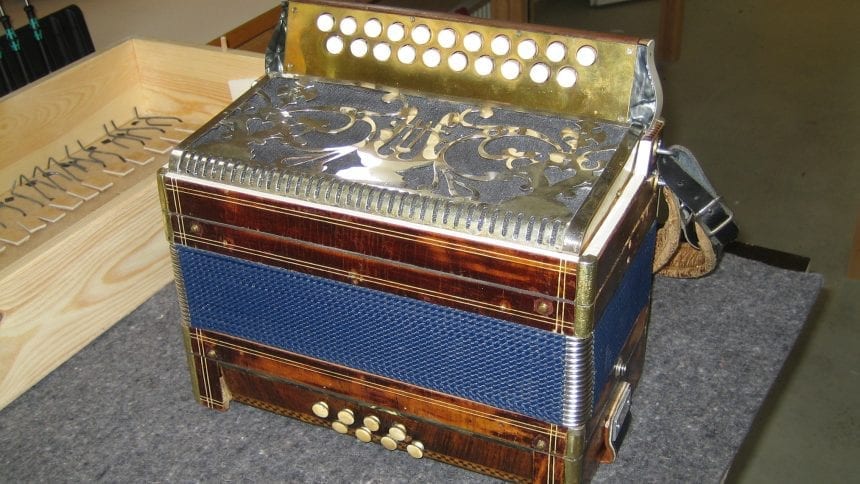There is no simpler accordion than a an one row accordion. It consists of the same main parts as other accordions: a treble, a bellows and a bass, but the instrument has a lot less parts compared to other accordion instruments. Not all models even have a register mechanism or a grill. The one-row accordions are usually with 2-4 sets of reeds, but the smallest one-row accordions can be also single voiced. The two-row accordions are sort of like a one-row accordion with one additional row and more bass keys. Structurally, the instruments are practically the same.
The history of diatonic accordions begins immediately after Demian’s accordion started to spread from Wienna. From the 1830s to 1850s, the first one-row accordions were found mainly in the German-speaking region of (nowadays) southern Germany and Austria. The instruments have practically not changed since the end of the 1800s. The main differences are in materials of reedplates and reeds, as well as in coatings and adhesives. Of course, the appearance varies a lot. As a rule, differences in one- and two-row accordions can be found in the manufacturing tradition. The diatonic accordion development in Europe is divided into two main groups: Viennese models and German models. A group of diatonic accordions has envolved in Russia, whose key systems are unique compared to European models. Russian diatonic accordions are having the same sound in both bellow direction, whilst in European tradition the tone is changing witch each bellow direction change. In the German-speaking region in the Central Europe a so-called helikon accordion, with very large reeds on the bass, is common. This accordion model is not used a lot elsewhere. The Helikon accordion can be a bisonoric or unisonoric.
The two-row accordions in Finland are mainly so-called minor chords accordions, with which f.ex. Emma and Kohmelo waltz can be played. The instruments are tied to the key and therefore the instruments can be classified based on this. In Finland, the most common two-row tuning is the G/C tune (outer row/inner row). In European music, the keys G/C, C/F, D/G and A/D are the most common. Irish music uses a lot of B/C and C#/D keys.
When exploring diatonic accordions, you will notice that there are incredibly many different types of diatonic instrument models. There are five established key types in one-row only, and some assisting keys may be added to the instruments next to the main row. In addition to these, the tuning vary very widely from soft waltz sounds to raw and sharp tuning, and so on. Useful information for those interested in diatonic accordions can be found in English at http://forum.melodeon.net. There is a wide range of information on the site for key systems and playing. Melodeon.net site also has a very good and international forum.
